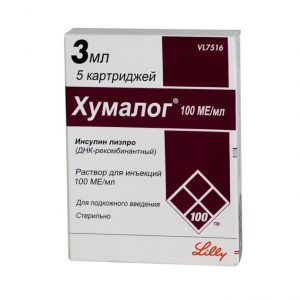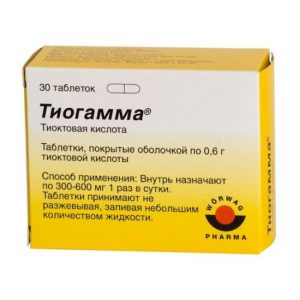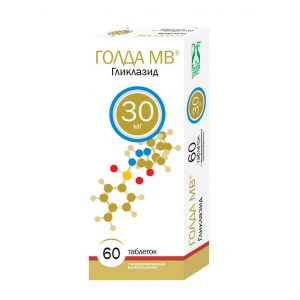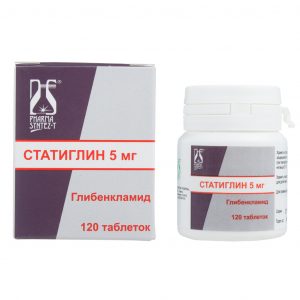Description
Pharmacological action
Glibenclamide has pancreatic and extrapancreatic effects. It stimulates insulin secretion by lowering the threshold of pancreatic beta-cell glucose irritation, increases insulin sensitivity and its binding to target cells, increases insulin release, enhances the effect of insulin on muscle and liver glucose uptake, and inhibits lipolysis in adipose tissue (extra-pancreatic effects) . Acts in the second stage of insulin secretion. It has a lipid-lowering effect, reduces the thrombogenic properties of blood. The hypoglycemic effect develops after 2 hours, reaches a maximum after 7-8 hours and lasts 12 hours. The drug provides a smooth increase in insulin concentration and a smooth decrease in glucose concentration in blood plasma, which reduces the risk of hypoglycemic conditions. Glibenclamide activity is manifested with preserved endocrine pancreatic function.
Pharmacokinetics:
Absorption of
When taken orally, absorption from the gastrointestinal tract is 48-84%. The time to reach the maximum concentration in the blood (Tmax) is 1-2 hours. The bioavailability of glibenclamide is 100%. Simultaneous eating does not significantly affect the absorption of glibenclamide.
Distribution
Distribution volume (Vd) 9-10 l. Communication with plasma proteins is 95-99%. The placental barrier passes poorly.
Metabolism
Glibenclamide is almost completely metabolized in the liver to form two inactive metabolites.
Excretion
One of the inactive metabolites is excreted by the kidneys, the other through the intestines in approximately equal proportions. The half-life (T1 / 2) is from 3 to 10-16 hours.
Pharmacokinetics in patients with impaired liver function
In patients with impaired liver function, the excretion of the active substance from blood plasma is slowed down.
Pharmacokinetics for renal failure
In patients with renal insufficiency, excretion of metabolites through the intestines increases compensatory. With creatinine clearance 30 ml / min. The total rate of removal of glibenclamide from the body remains unchanged, with severe renal failure, cumulation is possible.
Indications
Type 2 diabetes mellitus, in addition to diet therapy and exercise, as monotherapy or as part of combination therapy with metformin or other oral hypoglycemic drugs, other than sulfonylureas and clayides.
Contraindications
– Hypersensitivity to glibenclamide and / or any adjuvant of the
preparation – hypersensitivity to other sulfonylurea derivatives sulfonamides diuretics containing a sulfonamide group in the molecule probenecide, because cross reactions
may occur – type 1 diabetes mellitus
– diabetic ketoacidosis, diabetic precoma and coma
– state after pancreatic resection
– severe hepatic insufficiency
– severe renal failure (clearance of creatinine over 30 ml) severe
deficiency – decompensation of carbohydrate metabolism in infectious diseases, burns, injuries or after major surgeries, when insulin therapy is indicated
– intestinal obstruction, gastric paresis
– hereditary lactose intolerance, lactase deficiency or glucose and lactose malabsorption syndrome
– pregnancy and lactation
– children under 18 years of age (efficacy and safety have not been studied) srdkrd – simultaneous use with bosentan.
Caution:
Glibenclamide should be used with caution in case of febrile thyroid disease (with decreased function) deficiency of the anterior pituitary gland or adrenal cortex, glucose-6-dehydrogenase deficiency, chronic alcoholism, acute alcohol intoxication, the risk of malabsorption, and the risk of malnutrition and hypoglycemia (prolonged fasting, insufficient intake of carbohydrates with food, excessive physical exertion, diarrhea or vomiting) renal failure of mild to moderate severity (creatinine clearance 30 ml / min) of liver failure of mild to moderate severity of cerebral atherosclerosis in elderly patients over 65 due to the risk of development hypoglycemia.
Special instructions
The drug should be taken regularly and, if possible, at the same time. It is necessary to carefully observe the regimen of the drug and the diet. The doctor should carefully consider the appointment of glibenclamide in patients with impaired liver and kidney function, as well as with hypofunction of the thyroid gland, anterior pituitary or adrenal cortex. A dose adjustment of glibenclamide is necessary with physical and emotional overstrain, a change in diet.
Factors contributing to the risk of developing hypoglycemia include:
– patient reluctance or inability (more often seen in elderly patients)
to work with a doctor – malnutrition, irregular eating or skipping meals
– imbalance between physical activity and carbohydrate intake
– changing the
diet – drinking alcohol, especially in combination with skipping meals
– severe impaired renal function
– severe impaired liver function
– overdose of glibenclamide
– diar her, vomiting
– some decompensated endocrine disorders, disturbing carbohydrate metabolism or adrenergic counterregulation in response to hypoglycemia (for example, some dysfunctions of the thyroid gland and the anterior pituitary gland, adrenal cortex insufficiency)
– the simultaneous use of certain drugs.
Large surgical interventions and injuries, extensive burns, infectious diseases with febrile syndrome may require discontinuation of oral hypoglycemic drugs and the administration of insulin.
During treatment, it is not recommended to stay in the sun for a long time.
The use of sulfonylurea derivatives, which include glibenclamide, in patients with glucose-6-phosphate dehydrogenase deficiency can lead to hemolytic anemia, therefore hypoglycemic agents that are not sulfonylurea derivatives should be used.
The simultaneous use of drugs that have an effect on the central nervous system, lowering blood pressure (including beta-blockers), as well as autonomic neuropathy can mask the symptoms of hypoglycemia.
In elderly patients, the risk of developing hypoglycemia is slightly higher, therefore a more careful selection of the dose of the drug and regular monitoring of the concentration of glucose in the blood on an empty stomach and after a meal, especially at the beginning of treatment, are necessary.
Alcohol can provoke the development of hypoglycemia, as well as the development of a disulfiram-like reaction (nausea, vomiting, abdominal pain, sensation of heat of the face and upper body, tachycardia, dizziness, headache), so you should refrain from taking alcohol during treatment with glibenclamide.
Each time a doctor is changed (e.g. during hospitalization in a hospital, with a disease on vacation) the patient must inform the attending physician about that. that he has diabetes.
Fertility
No data on the effect of glibenclamide on fertility.
Impact on the ability to drive transp. Wed and fur .:
When taking glibenclamide, the development of hypoglycemia is possible, and, as a consequence, a decrease in reaction and ability to concentrate, therefore, during treatment with the drug, care must be taken when driving vehicles and engaging in other potentially dangerous activities that require concentration and speed psychomotor reactions.
Composition
Composition per tablet:
Active ingredient: glibenclamide 1.75 mg
Excipient: lactose monohydrate – 46.5 mg povidone K30 – 1.75 mg hyprolose low substituted – 11.5 mg microcrystalline cellulose – 23.5 mg sodium carboxymethyl starch – 4.0 mg of silicon colloidal dioxide – 0, 5 mg sodium stearyl fumarate – 0.5 mg.
Dosage and Administration
Inside. The drug should be taken before meals, without chewing and drinking plenty of fluids. The drug should be taken at the same time of day.
The dose of the drug is selected individually depending on age, severity of diabetes mellitus, fasting blood glucose concentration and 2 hours after eating. A dose adjustment is necessary when changing the body weight and lifestyle of the patient. Regular monitoring of the concentration of glucose in blood and urine, glycated hemoglobin, and indicators of lipid metabolism is also necessary.
tablets 5 mg. The tablet can be divided into 2 equal parts. The daily dose range is from up to 3 tablets (from 2.5 mg to 15 mg). The initial dose is 2.5-5 mg ( – 1 tablet) per day. The maximum daily dose is 15 mg (3 tablets).
An increase in dose should be carried out at intervals from several days to 1 week until the desired therapeutic dose is reached, which should not exceed the maximum.
Tablets 1.75 mg. The initial dose is usually 1-2 tablets (1.75 mg – 3.5 mg) 1 time per day. The average daily dose is 3.5 mg (2 tablets). If necessary, the dose is gradually increased until adequate glycemic control is achieved. The maximum daily dose is 6 tablets (10.5 mg). If it is necessary to take more than three tablets, they switch to taking tablets with a dosage of 3.5 mg.
An increase in dose should be carried out at intervals from several days to 1 week until the desired therapeutic dose is reached, which should not exceed the maximum.
Tablets 3.5 mg. The initial dose is usually – 1 tablet 1 time per day. The average daily dose is 3, 5 mg (1 tablet). If necessary, the dose is gradually increased until adequate glycemic control is achieved. The maximum daily dose is 10.5 mg (3 tablets).
Daily doses of up to 2 tablets are usually taken once a day, in the morning. Higher doses are divided into 2 doses – morning and evening doses in a ratio of 2: 1.
If you skip one dose of the drug, the next dose should be taken at the usual time, and you are not allowed to take a higher dose.
Transition from other hypoglycemic drugs
When switching from other hypoglycemic drugs with a similar type of action, glibenclamide is prescribed according to the scheme above, and the previous drug is immediately canceled.
Use as part of combination therapy with other hypoglycemic drugs
Glibenclamide can be used as part of combination therapy with metformin and other oral hypoglycemic drugs that do not stimulate insulin secretion (guar gum or acarbose). In case of metformin intolerance, a combination of glibenclamide with thiazolidinediones (rosiglitazone, pioglitazone) can be recommended, with the initial stage of secondary resistance to glibencamide with insulin. In the case of complete secondary resistance to glibencamide – insulin monotherapy.
Use in the elderly, debilitated patients and patients with reduced nutrition
In the elderly, debilitated patients or patients with reduced nutrition, the initial and maintenance doses must be reduced because of the risk of hypoglycemia.
Children and adolescents
There are no data on the efficacy and safety of glibenclamide in this age group.
Use in patients with impaired renal and hepatic function
The use of glibenclamide in patients with severe renal and hepatic insufficiency is contraindicated. In patients with mild and moderate renal failure (creatinine clearance 30 ml / min) and mild and moderate hepatic insufficiency, the initial and maintenance doses must be reduced because of the risk of hypoglycemia.
Overdose
In case of an overdose, hypoglycemia may develop. This condition can take a protracted nature and contribute to the development of severe conditions, up to a comatose, life-threatening patient or ending fatally. In case of diabetic polyneuropathy or with concomitant treatment with sympatholytic agents (see Interaction with other medicinal products section), typical precursors of hypoglycemia may be mild or absent altogether.
Symptoms of hypoglycemia: a strong feeling of hunger, sudden profuse sweating, palpitations, pallor and decreased temperature of the skin, paresthesia of the oral mucosa, trembling, general anxiety, headache, pathological drowsiness, sleep disturbances, feelings of fear, impaired coordination of movements, temporary neurological disorders (e.g., visual and speech, manifestations of paresis and paralysis or altered perceptions of sensations). With the progression of hypoglycemia, loss of self-control and consciousness is possible, a predisposition to seizures develops.
Treatment: For mild or moderate hypoglycemia, dextrose (glucose) or a sugar solution must be taken orally.
In case of severe hypoglycemia, accompanied by loss of consciousness, 40% dextrose solution or glucagon is administered intravenously, intramuscularly, subcutaneously. After regaining consciousness, the patient must be given carbohydrate-rich foods to prevent the re-development of hypoglycemia.
Storage conditions
In a dry, dark place at a temperature of no higher than 25 ° C.
Keep out of the reach of children.
Expiration
3 years.
Do not use after expiration date.
Terms and conditions
prescription
Formulation
tablets




